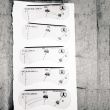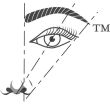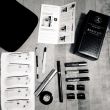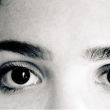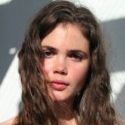I can’t remember the first time I plucked my eyebrows, but the first time I shaved them was in fifth grade. My stepbrother had been making fun of my unibrow, which until then I hadn’t known I’d had. “Well, at least I have two eyebrows,” he said, ending whatever stupid fight we were having with a comment that was both confusing and clearly an insult, so I said something like, “Whatever, fuck you,” and ran off to the bathroom to check my face, on the unlikely chance that one of my eyebrows had literally fallen off, leaving a single strip over one eye. But looking in the mirror, I realized he meant that mine joined in the middle.
A few minutes later, I dragged my stepmother’s plastic razor down my forehead between my eyes (is there a name for that area?), slightly off-center.
--
I read something recently, an excerpt from an old etiquette book, about how looking in the mirror is a waste of time and people should never do it, or be caught doing it, and I thought it was brilliant. Because, imagine if we got rid of mirrors. Obviously there are some holes in this—like if you had a mole that started getting weird in a place other people wouldn’t normally look, and I know that science needs mirrors—but it could be so fascinating. The entire fashion world, for instance, might crumble but also rebuild itself in a new way. Ditto the beauty industry. And we’d all have to rely on one another a lot more, and be more engaged: “You should try this in green instead.” Maybe we’d pick clothes out for one another more often. Who knows.
Meanwhile, mirrors still exist, and in fifth grade I shaved off my unibrow, and it looked like shit, but then it grew back, and somewhere along the way, my mom or stepmom gently guided me toward tweezers. So then I had a too-wide-apart thing going (overcorrection?), and then they got really skinny, or skinny-ish, and stayed that way for about 15 years. I probably plucked them for at least 10 minutes every day.
And then last year, my friend Jane Marie convinced me to let them grow in. It seemed crazy, until I spent a long weekend with another friend who didn’t have mirrors in his house—mirrors!! I’m telling you—so my brows got past that awkward patchy stage without me noticing, except that it didn’t matter because no one ever really notices your eyebrows. If you ask almost any woman who’s ever fussed over her face in a mirror, she’ll tell you that her eyebrows are “really asymmetrical,” but then she just looks normal. It’s also an implicit admission that she spends too much time in the mirror. Mirrors, don’t let them win.
In any case, my eyebrows are really asymmetrical, so growing them in after such a long time meant discovering that one patch on one eyebrow grows one way and the other grows another. Fascinating stuff.
No, but we really do have to get rid of mirrors. Mirror, mirror, on the wall— not anymore. ** *shatters *** We don’t need to know so much about the way we look, beyond maybe occasional gazes into a pool of water. Who invented the mirror, anyway? I went to the Wikipedia page for mirrors, and the photograph of the vase looking at itself in a mirror unexpectedly made me laugh, although by describing it, I’ve maybe ruined it. Anyway, this seems to be the answer:
Metal-coated glass mirrors are said to have been invented in Sidon (modern-day Lebanon) in the first century AD, and glass mirrors backed with gold leaf are mentioned by the Roman author Pliny in his Natural History , written in about 77 AD. The Romans also developed a technique for creating crude mirrors by coating blown glass with molten lead
But also:
In China, people began making mirrors with the use of silver-mercury amalgams as early as 500 AD. Some time during the early Renaissance, European manufacturers perfected a superior method of coating glass with a tin-mercury amalgam. The exact date and location of the discovery is unknown, but in the 16th century, Venice, a city famed for its glass-making expertise, became a centre of mirror production using this new technique.
And then: “The invention of the silvered-glass mirror is credited to German chemist Justus von Liebig in 1835.”
I encourage you to check out the mirror Wikipedia page; it’s great. For a long time, if you’d asked me how mirrors were made, I’d have told you they were made “of mirror,” as if mirror were an element, like iron or something.
Anyway, my eyebrows are now fully grown out, feathery-thick and almost touching one another (but not straight across, more like downward to hold hands in secret). And if I’d truly spent 10 minutes plucking my eyebrows every day, I think that means I just bought myself back 38 days every 15 years. Which I should maybe spend brushing up on math, because that just took me an amazingly long time to figure out.
Eyebrows in their natural state are excellent canvases for a level of eyebrow “shaping' far beyond what I'm capable of, so I visited a master eyebrow-shaper, to get her so-called perfect brow. Although the more I think about eyebrows—not that there’s a lot of extra room, given how much I already think about them—the more I believe the right answer is for no one to pluck anything, and for everyone to just be the “natural” version of themselves. At least for five years. And then the mirrors could come back—first as expensive hand-held ones, maybe.
Well, this has been fun, and I am happy that this essay about eyebrows has made it all the way to Congress and to Stonehenge and up to the aliens, and that whoever’s in charge will, at the crack of midnight, magically eliminate all non-necessary mirrors. ‘Necessary mirrors’ being the science ones…and the other necessary ones I’m not thinking of. I guess with cars they are useful. Although maybe we should stop driving.
But I went to Sania Vucetaj, “NYC’s eyebrow expert,” at her NYC salon, Sania’s Brow Bar, at 48 W. 20th Street, where she tweezed so quickly and painlessly that it reminded me of one of those scenes in a cartoon where a hairdresser goes into a flurry, all windmill arms and snipping noises, and then suddenly it’s like, ta-da, the person’s hair is perfect. She’s gentle and warm, and didn’t make me feel bad about my eyebrows, or about how sweaty I happened to be that day. A licensed aesthetician, Sania’s been doing eyebrows professionally for more than 20 years, operated her own salon for nine, and has been eyebrow-obsessed for as long as she can remember, because her sisters would tease her for a scar that bisects one of her own eyebrows (not that I could see it). Kids and eyebrows, man! She started as a brow specialist at Bergdorf Goodman’s beauty spa and opened Sania’s Brow Bar after she left, in 2004.
Her general philosophy is that bolder and more grown-in is better, as fuller brows tend to make people look younger (and vice versa), but that eye/eyebrow geography dictates ideal fullness. Or, in her words: “The space between the brow and the lid should determine how full your brows can be.” For instance: “If you have very full brows, but the space between the brow and the lid is minimal, it feels closed and makes the eye area look heavy, dark, and overwhelming. Taking off a few more hairs below the brow will open this space up, giving a brighter lift while still looking natural and full enough—having full brows is not more important than a flattering fullness.” Also: “If a women has lots of space between her brows and eyelids, removing too much hair takes away from the eyebrow's frame, making it look unconnected to the eye and unnatural. Women usually do this to get more of an arch and lift, but if you keep a fuller brow in the front and then taper upwards for that lift effect, it creates a natural, lifted look, and flatters the eye.” (She’s not a fan of waxing, by the way: “It pulls too much on the skin.”)
The whole thing took about 10 minutes. First, she dealt with the asymmetrical patch of eyebrow on one side of my face by trimming its top (!?!?! never before—this is a revelation) and adding some light brown pencil. She added pencil elsewhere, including all along the tops of my eyebrows—if that makes sense—essentially lifting them up a little, visually, before blending everything in with a small mascara-type brush. She’s a genius. She also costs $65.
I loved the look, but it only lasted for two or three days, or maybe just one, depending on when the brow pencil wore off, but it was amazing until then, and theoretically I now know how to do them myself. (For a before-and-after, see slide #2 above; the left is Sania's work, the right is my natural brow.)
I asked Sania if her friends harassed her all the time to do their eyebrows, and she laughed and told me that she usually can’t drink at parties because as soon as she arrives, her friends are like, No, no drinks for you, you’re doing eyebrows! And I was like, ‘Oh that sucks,’ but I’d probably do the same thing if I were Sania’s friend. And Sania really loves eyebrows, so maybe it’s OK.
Among my other favorite things Sania told me were that people shouldn’t use magnifying mirrors—preach, Sania!—because they’re depressing, unnecessary, and usually make you take off too much hair; and that, if you’re trying to grow your eyebrows in (or just want to maintain them, in general), you should keep moisturizers, sunscreens, brow gels, and basically anything with oils in it away from your eyebrow area, because oil inhibits hair growth. I love this. Do less? Great. Her own eyebrows, in case anyone’s wondering, are strong, dark, and…dynamically arched? She claims there’s a universal brow shape that’s flattering to every face, which I was initially skeptical about, but she said it with such conviction—and in a way that indicated she’d probably had the same exchange many times—that now I’m on board. And though I feel like I’m running out of words to describe eyebrows, or did long ago, that universal shape is, basically: lightly arched, symmetrical, and on the thicker side.
She also taught me more about the three eyebrow spots, which anyone who reads too many women’s magazines probably already knows about (and yet is still mildly bewildered by??): where a brow “should” start (where a line from the side of the nose intersects it); the high point of its arch (where a line from the outside of the nostril over the center of the pupil intersects it); and where it should end (where a line from the corner of the nose to the outer corner of the eye intersects it).
Or, because that was probably even more confusing to read than it was to write, take a look at a picture [3], although now we’re swapping coasts and looking at LA-based brow-master Anastasia Soare’s (trademarked!) “ Golden Ratio” eyebrow.
Anastasia’s 5-Element Brow Kit ($65) [4] was included in the package ITG sent me for this story, and it came with a slightly longer guide to these three eyebrow spots. To achieve the Golden Ratio brow, instructions say, you’re supposed to find your own three spots, then match your general brow shape—based on the three spots—to one of the six stencils enclosed (from “petite arch” to “full arch” to “slim high arch”), and finally press the stencil to your brow and fill it in with powder.
I played with this set a few days before visiting Sania, and my friend Logan very kindly agreed to be my guinea pig. I think neither of us had particularly high hopes for this experiment, because of the general weirdness of using a stencil [5] to draw something onto a face, and because of my lack of makeup-applying skill, but I surprised both of us by creating a pretty decent look, above [6].
Logan said she liked it. “I wish you would stencil eyebrows on me every morning!” she later wrote when I asked her for a review. It’s possible she was just humoring me, but I ran into her the next day, and she told me she hadn’t yet washed her face, because she liked her new brows so much. And they did look really good. I used the Anastasia Brow Gel on her, though, and that doesn’t jibe with Sania’s rule of not using oil-based products or gels (she says they’re growth inhibitors, but I’m also now envisioning Sania and Anastasia in some kind of Mortal Kombat Brow Off), so I subsequently gave Logan a heads-up about that. She didn’t seem to care, and I may have actually, finally exhausted her interest in talking about eyebrows.
Me too, maybe. Since I saw Sania, I haven’t plucked or otherwise tended to my own, but I also haven’t been shaving, and my eyeglasses cover the unibrow part, so it’s not really much of a ‘statement.’ But I do like the feral look. And it’ll be easy to maintain when the mirrors disappear.
—Edith Zimmerman
Edith Zimmerman is a Brooklyn-based writer and editor. This is her website. You can read her other ITG stories here (A Skin Thing), here (The Edith Zimmerman Diet), and here (Edith Zimmerman is Throwing Everything Out). Photos courtesy of the author.








